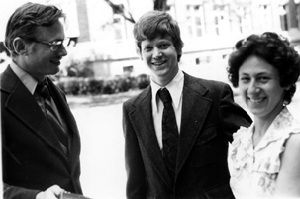About
History
The first existence of the environmental health program traces back to the earliest days of the University of Minnesota when the State Board of Health transferred to the campus and began offering courses in “sanitary sciences” addressing topics in sewage, ventilation, lighting, and heating of private homes.
 By the 1930s, the formalized Division of Sanitation and Public Health Engineering had emerged under the direction of Professor George Pierce within what was then known as the University’s Health Department. In 1949, Professor Herbert Bosch partnered with Ruth Boynton, director of the health service, to create a program dedicated to the control of environmental hazards called public health engineering and later renamed environmental health.
By the 1930s, the formalized Division of Sanitation and Public Health Engineering had emerged under the direction of Professor George Pierce within what was then known as the University’s Health Department. In 1949, Professor Herbert Bosch partnered with Ruth Boynton, director of the health service, to create a program dedicated to the control of environmental hazards called public health engineering and later renamed environmental health.
In recent history, the Division of Environmental Health Science has continued to expand its research and academic programs. The division offers graduate, doctoral, and joint degrees in diverse concentrations. These concentrations focus on important and emerging issues in environmental health, including infectious diseases, toxicology, exposure sciences, environmental chemistry, occupational hygiene, medicine and nursing, epidemiology, injury prevention, and global health. Research continues to play a vital role as the division is home to multiple research and education centers, and collaborations with partner institutions.
Environmental Health Sciences Historical Timeline
In 1874 the University offers instruction in public hygiene, including “sewerage and drainage of towns, heating, lighting and ventilation of dwellings and public buildings.”
1922-1944 – Courses in sanitary science are taught by Health Department staff.
1939 – Drs. William and Charles Mayo provide endowment to help establish a School of Public Health and a Mayo Professorship in Public Health. 1944 The Board of Regents creates the School of Public Health (SPH). The man named head of the new school, Gaylord Anderson, is serving in the U.S. Army Medical Corps at this time, so student health service director Ruth Boynton holds his place.
1945-1951 – Dr. Gaylord Anderson and Harold Whittaker expand programs for health officers, public engineers and public health nurses that lead to masters degrees.
1951-1961 – Herbert Bosch is director of environmental health program and adds courses in air pollution and control of radiation hazards.
1959 – Richard Bond and Dr. Ruth Boynton develop a program in environmental health and safety and collaborate with Bosch to develop courses in water and food sanitation, air pollution, laboratory safety, occupational hygiene, and accident prevention.
1959-1970 – Summer course in ground water development brings in hundreds of engineers from developing countries. NASA planetary quarantine research projects are funded.
1962-1973 – Richard Bond is named department director. Courses are developed in hospital engineering and radiation protection.
1973-1981 – Conrad Straub becomes head and expands research mission on department. Midwest Center for Occupational Health and Safety (MCOHS) is funded.
1981-1989 – Donald Barber serves as head and creates environmental chemistry and toxicology specialty tracks. Occupational and Environmental Health Nursing, environmental and occupational epidemiology, and occupational injury control programs are added.
1989-1995 – Ian Greaves is recruited as division head; adds environmental health policy specialty. Richard G. Bond Professorship endowment is created.
1995-1999 – Jack Mandel becomes division head and is named Mayo Chair in Public Health. There are 22 faculty members in the division and research funding exceeds $2 million annually.
2000-2014 – William A. Toscano, Jr. is appointed division head in June 2000. Under his leadership the division continues to build strong research and educational programs. Two new specialty tracks, exposure sciences and global environmental health, are added. The Upper Midwest Agricultural Safety and Health Center (UMASH) is funded.
2014-present – Bruce H. Alexander is named division head in 2014. The division begins to expand its faculty in injury and violence prevention, systems toxicology, exposure science, environmental infectious disease, and global health. New initiatives include a doctoral program in systems toxicology, a 4/1 BS/MPH degree with the College of Biological Sciences, and the Exposure Science and Sustainability Institute is established.
Key Contacts
Finance/Human Resources/Grants/Certified Approver
Debb Grove, Division Administrator
grove020@umn.edu
612-626-4803
Main Office/Administrative
Shelly Ring, Office Supervisor
bacig007@umn.edu
612-626-0900
Computer/IT Support
enhs-it@umn.edu
612-626-8160
Finance/Payroll
Bridget Brennan, Accountant
brenn006@umn.edu
612-624-6993
Grants
Joann Larson, Grants Manager
larsonjm@umn.edu
612-624-6196/612-626-4512
Student Services
Katie Keyser, Student Services Coordinator
loas0001@umn.edu
Ned McCully, Student Services Coordinator
nmccully@umn.edu
Web, Graphic Design, Communications
Joy Archibald, Web Coordinator
archi009@umn.edu
VISION
A world in which environmental justice and health equity prevail.
MISSION
The Division of Environmental Health Sciences improves the health of individuals and communities by conducting rigorous and collaborative research to identify risks, reduce hazards, and inform public health policies, and by providing outstanding interdisciplinary education to prepare future environmental health practitioners and leaders.




